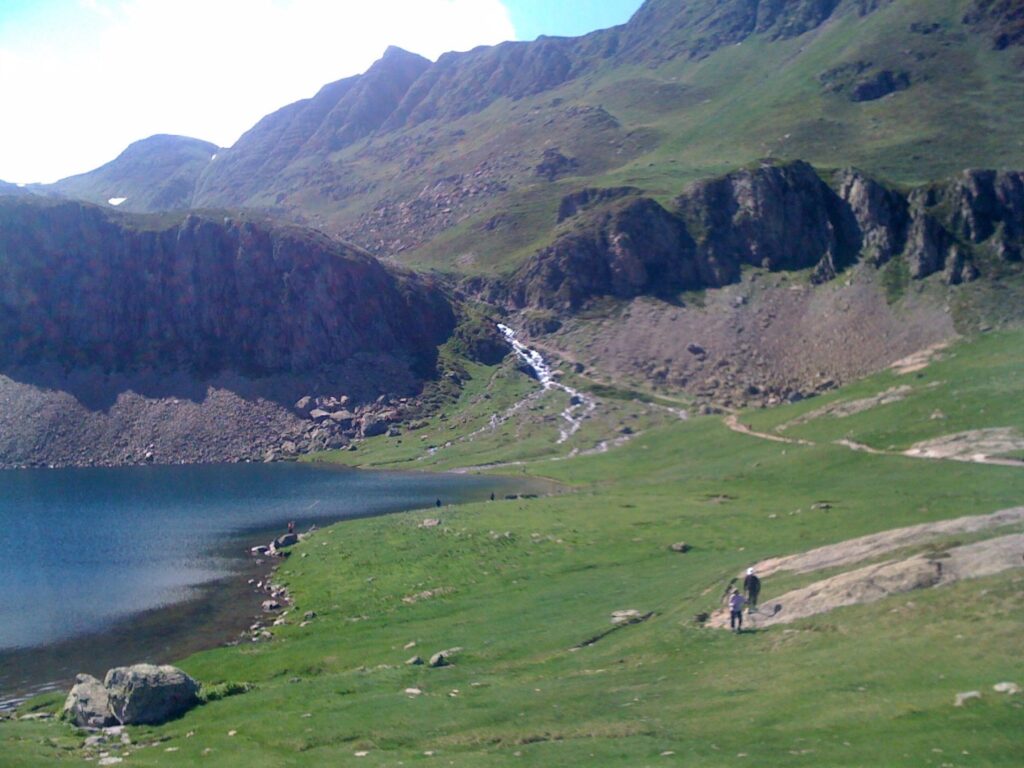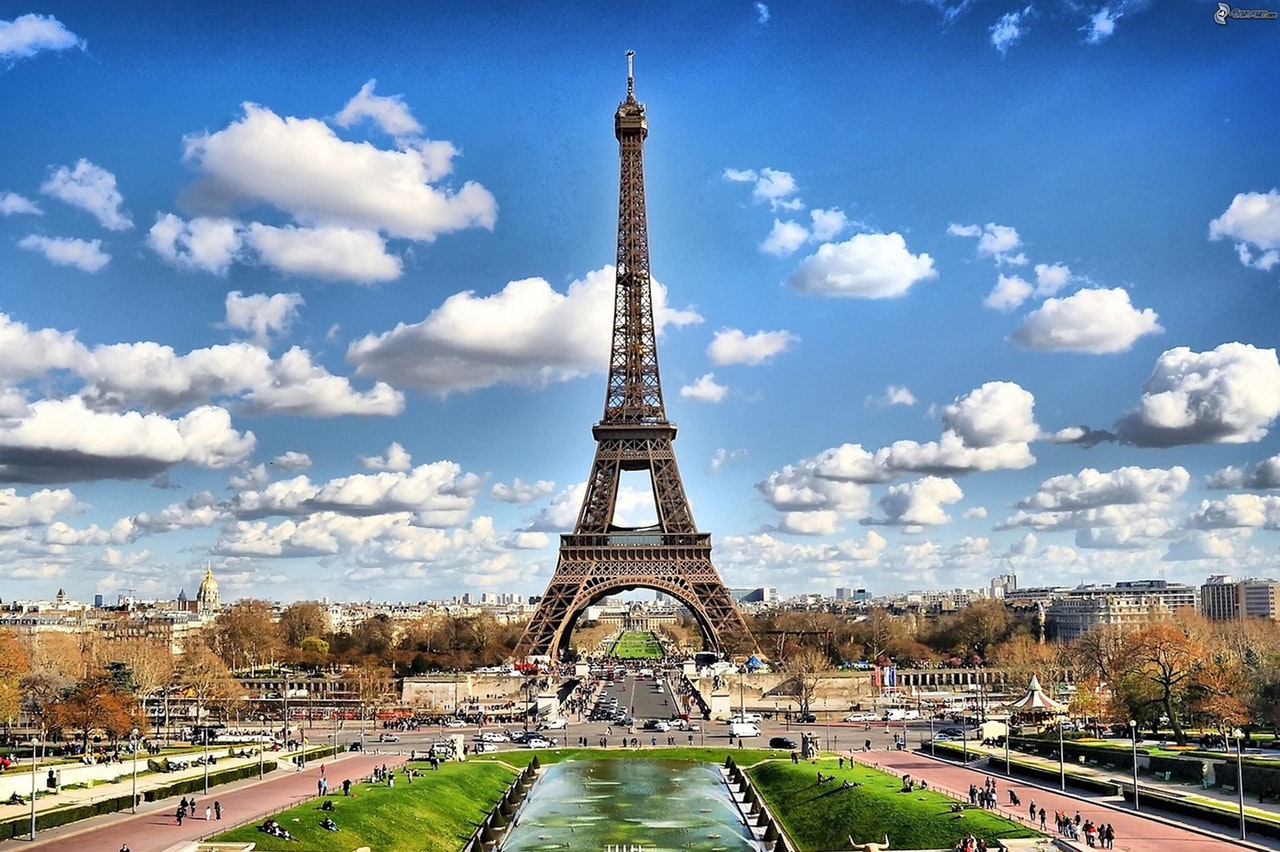France is a country known for its rich history, culture, cuisine, and natural beauty. It is the largest country in the European Union and has a diverse landscape that includes mountains, beaches, vineyards, and cities. Paris, the capital city, is famous for its iconic landmarks like the Eiffel Tower, Notre-Dame Cathedral, and the Louvre Museum. The French language, fashion, and cuisine are recognized around the world, and the country is home to many famous artists, writers, and intellectuals. Here are 20 of the best places to see in France:
Eiffel Tower, Paris:
The most iconic symbol of France, the Eiffel Tower is a must-visit when in Paris. The Eiffel Tower is an iconic landmark and one of the most recognizable structures in the world, located in Paris, France. It was built in 1889 as the entrance arch for the World’s Fair and was named after its designer, Gustave Eiffel. The tower stands at 324 meters tall and is made of wrought iron. It has three levels accessible to the public, each offering stunning views of the city of Paris. The Eiffel Tower is not only a popular tourist attraction but also an important symbol of France and a testament to the beauty and elegance of engineering and design.
The Louvre Museum, Paris:
The Louvre Museum is one of the world’s largest and most famous art museums located in Paris, France. It is housed in the Louvre Palace, a former royal residence that dates back to the late 12th century. The museum’s collection spans over 9,000 years of history and includes over 380,000 objects, ranging from ancient Egyptian artifacts to modern art. Some of the most famous works on display at the Louvre include the Mona Lisa by Leonardo da Vinci, the Winged Victory of Samothrace, and the Venus de Milo. The Louvre Museum is a must-visit destination for art lovers and history buffs alike, attracting millions of visitors each year from around the globe.
Mont-Saint-Michel:
Mont-Saint-Michel is a small tidal island located off the coast of Normandy, France. It is famous for its medieval abbey, which is perched on top of a rocky peak and can be seen from miles away. The island has been a place of pilgrimage for centuries and attracts millions of visitors each year. The surrounding bay is also known for its strong tidal currents, which can create dramatic changes in water level and make the island appear to be floating on the sea. The island and its abbey have a rich history and have been the site of many important events, including battles and religious ceremonies.
Palace of Versailles:
The Palace of Versailles is a magnificent royal chateau located in Versailles, France, approximately 20 kilometers southwest of Paris. It was originally built as a hunting lodge in 1624, but was later expanded by Louis XIV in the late 17th century to become a grand palace and center of political power in France. The palace is renowned for its opulent Baroque architecture, exquisite gardens, and elaborate interior decoration, including works by famous artists such as Charles Le Brun and Hyacinthe Rigaud. The palace also played a significant role in the history of France, including the signing of the Treaty of Versailles, which ended World War I. Today, the Palace of Versailles is a UNESCO World Heritage site and a popular tourist destination, attracting millions of visitors each year.
Notre-Dame Cathedral, Paris:
Notre-Dame Cathedral is a historic Catholic cathedral located on the Île de la Cité in the heart of Paris, France. The construction of the cathedral began in 1163 and was completed nearly two centuries later, in 1345. It is widely considered to be one of the finest examples of French Gothic architecture, characterized by its tall spires, flying buttresses, and intricate stone carvings.
The cathedral has played an important role in French history, serving as the site of numerous royal coronations and other significant events. It is also famous for its impressive stained glass windows, including the large rose window on the western facade. In April 2019, the cathedral suffered extensive damage due to a devastating fire that destroyed the roof and spire, but plans are underway to restore the historic landmark.
The French Riviera:
A glamorous stretch of coastline in the south of France, home to cities such as Nice, Cannes, and St. Tropez. The French Riviera is also known as the Côte d’Azur, is a glamorous coastal region that stretches from the Italian border to the town of Saint-Tropez. It is known for its stunning turquoise waters, picturesque villages, luxury resorts, and vibrant nightlife. The region’s warm climate and beautiful beaches have made it a popular destination for tourists and celebrities alike, with many famous personalities owning homes in the area. The French Riviera is also renowned for its delicious cuisine, particularly its seafood and Provencal dishes, as well as its world-class museums and galleries. Overall, the French Riviera is a captivating destination that offers a perfect mix of sun, sea, culture, and luxury.
Dordogne:
The Dordogne is a region located in southwestern France, known for its beautiful countryside, picturesque villages, prehistoric caves, and castles. The region is named after the Dordogne river that runs through it and is a popular destination for tourists due to its rich history, culture, and natural beauty. Visitors can explore medieval towns like Sarlat, sample the local cuisine such as foie gras and truffles, and visit the many historic sites and landmarks including the Lascaux cave paintings and the Château de Beynac. The region is also home to numerous outdoor activities such as hiking, canoeing, and cycling.
Bordeaux:
Bordeaux is a city located in southwestern France, near the Atlantic coast. It is the capital of the Gironde department and the Nouvelle-Aquitaine region. Bordeaux is known for its world-renowned wines, which are produced in the surrounding vineyards. The city is also famous for its historic architecture, particularly its elegant 18th-century buildings and wide, tree-lined boulevards. Bordeaux has a rich cultural scene, with numerous museums, galleries, and theaters. It is a popular tourist destination, attracting millions of visitors each year. Additionally, the city has a thriving economy, with a strong focus on the aerospace, electronics, and biotech industries.

Strasbourg:
Strasbourg is a city located in northeastern France, near the border with Germany. It is the capital of the Alsace region and the Bas-Rhin department. The city is known for its picturesque architecture, blending German and French styles, as well as its rich cultural heritage. Strasbourg is home to several important institutions, including the European Parliament and the Council of Europe, which has led to its reputation as a symbol of European unity. The historic center of the city, known as Grande Île, is a UNESCO World Heritage Site and features landmarks such as the Gothic Cathedral of Notre-Dame and the Petite France neighborhood, known for its charming half-timbered houses and canals. Strasbourg is also famous for its Christmas market, one of the largest and oldest in Europe.
The Loire Valley:
The Loire Valley is a region in central France known for its stunning châteaux (castles), historic towns, picturesque vineyards, and beautiful landscapes. The area is defined by the Loire River, which flows through the region and is surrounded by rolling hills and lush forests. The Loire Valley is also famous for its excellent wines, particularly its white wines made from the Sauvignon Blanc grape. The region has a rich cultural and historical heritage, with numerous castles and other historic landmarks dating back to the Renaissance period. The Loire Valley has been designated a UNESCO World Heritage site for its outstanding natural beauty, cultural significance, and historical importance. It is a popular destination for tourists seeking to explore France’s diverse cultural and natural treasures.
The French Alps:
The French Alps are a stunning mountain range located in southeastern France, bordering Italy and Switzerland. With some of the highest peaks in Europe, including Mont Blanc, which stands at 4,810 meters (15,781 feet), the French Alps offer breathtaking scenery and year-round outdoor activities.
In the winter, the French Alps are a popular destination for skiing and snowboarding, with numerous ski resorts offering world-class facilities and slopes. In the summer, visitors can enjoy hiking, mountain biking, and rock climbing in the beautiful alpine landscapes.

The French Alps are also home to picturesque towns and villages, such as Chamonix, Annecy, and Grenoble, each with their own unique charm and history. The region is also renowned for its culinary delights, with local specialties including fondue, raclette, and tartiflette.
Overall, the French Alps are a must-visit destination for anyone looking to experience the natural beauty and outdoor activities of the mountains, while also enjoying the unique culture and cuisine of France.
Avignon:
Avignon is a city located in southeastern France, in the Provence-Alpes-Côte d’Azur region. It is known for its rich history, including its role as the seat of the papacy in the 14th century. The city is home to many historic landmarks, including the Palais des Papes (Palace of the Popes), which served as the papal residence during the Avignon Papacy. Avignon is also known for its cultural events, particularly the annual Avignon Festival, which showcases theater, dance, and music performances. The city is surrounded by beautiful landscapes, including the Rhône River and the picturesque countryside of Provence. Today, Avignon is a popular tourist destination, attracting visitors from around the world who come to explore its history, culture, and natural beauty.
Carcassonne:
Carcassonne is a popular board game designed for two to five players, named after the fortified city in southern France. The game is played by placing tiles depicting various features of a medieval landscape, such as roads, cities, monasteries, and fields. Players take turns placing their own meeples, or tokens, on the features depicted on the tiles, in order to score points. The game is known for its simple rules, strategic depth, and elegant design, and has won numerous awards since its release in 2000.
Saint-Malo:
Saint-Malo is a coastal city located in the Brittany region of northwestern France. It is situated on a rocky promontory jutting out into the English Channel and is surrounded by high walls that date back to the 18th century. The city is known for its rich history, which includes being a major port for trade and piracy during the 17th and 18th centuries, as well as being the birthplace of famous French writer Chateaubriand. Today, Saint-Malo is a popular tourist destination, offering visitors a chance to explore its historic old town, enjoy its beaches and coastal scenery, and sample its local cuisine.
Giverny:
Giverny is a small village located in the Normandy region of northern France, about 80 kilometers northwest of Paris. It is known for its picturesque scenery, particularly its gardens and water lily pond, which were famously painted by the French Impressionist artist Claude Monet in the late 19th and early 20th centuries. Today, visitors can explore Monet’s house and gardens, as well as other attractions in the village such as the Museum of Impressionism and the Church of Sainte-Radegonde. Giverny is a popular destination for art lovers and tourists seeking a peaceful and scenic getaway.
Arles:
Arles is a city in the south of France, located in the region of Provence-Alpes-Côte d’Azur. It is situated on the banks of the Rhône River and has a rich history that dates back to Roman times. Arles is known for its well-preserved Roman monuments, including the Roman amphitheater and the Roman theater, both of which are UNESCO World Heritage sites. The city is also famous for its connection to the painter Vincent van Gogh, who lived and worked in Arles for a period of time and created many of his famous paintings there. Today, Arles is a vibrant city with a thriving arts and culture scene, and it attracts many visitors from around the world.
The Calanques, Marseille:
The Calanques are a series of rocky inlets located along the Mediterranean coastline near Marseille, France. These stunning natural formations are characterized by steep cliffs that rise dramatically from the turquoise waters below, creating a breathtaking landscape that is popular with hikers, climbers, and beachgoers alike.
The Calanques stretch for over 20 kilometers between Marseille and Cassis, and encompass a diverse range of environments, from rugged limestone cliffs to sandy beaches and pristine turquoise coves. The area is home to a rich variety of flora and fauna, including rare bird species, wildflowers, and aromatic plants like lavender and rosemary.

Visitors to the Calanques can explore the area by foot, following well-marked hiking trails that wind through the rugged terrain. There are also several beaches that offer opportunities for swimming, sunbathing, and snorkeling in the crystal-clear waters of the Mediterranean. Overall, the Calanques are a must-see destination for anyone visiting Marseille or the surrounding area, offering a unique and unforgettable natural experience.
Toulouse:
Toulouse is a city located in the southwestern part of France. It is the capital of the Occitanie region and the Haute-Garonne department. With a population of around 500,000 people, it is the fourth-largest city in France.
Toulouse is known as the “Pink City” due to the distinctive pinkish hue of many of its buildings, which are made of brick. It is also famous for its rich history, architecture, and cultural heritage. The city has many beautiful landmarks, such as the Basilica of Saint-Sernin, the Capitole de Toulouse (city hall), and the Canal du Midi, which is a UNESCO World Heritage Site.
Annecy:
Annecy is a picturesque city located in the French Alps, in the Haute-Savoie department of France. It is known for its stunning natural beauty, with its crystal-clear lake surrounded by mountains and its charming historic town center, featuring colorful buildings and narrow streets. Annecy is also famous for its canals and waterways, earning it the nickname “Venice of the Alps”. The city has a rich history dating back to the Middle Ages, with many architectural and cultural treasures to discover, including the impressive Château d’Annecy and the Palais de l’Isle, a former prison that is now a museum. Annecy is a popular destination for outdoor enthusiasts, offering a range of activities such as hiking, cycling, skiing, and water sports on the lake.
Nimes:
Nîmes is a city located in the south of France, in the Occitanie region. It has a rich history dating back to the Roman Empire, which is reflected in its numerous architectural landmarks such as the Arena of Nîmes, the Maison Carrée, and the Tour Magne. Nîmes is also known for its beautiful gardens, including the Jardins de la Fontaine, as well as its traditional bullfighting events. The city is situated in the beautiful countryside of the Languedoc region, making it a popular destination for tourists seeking a mix of culture, history, and natural beauty.




